ONE GARDENER TO ANOTHER: Living privacy screens
Published 6:45 am Monday, July 30, 2018

- Homeowners use plants as screens to designate property lines, hide unsightly views, and to block wind, noise and the peeping eyes of neighbors.
I grew up in Philadelphia in what is known as a row house. Real estate agents are now calling them town homes, and I guess they think that sounds better.
A row house is just what the name implies, any row of houses joined by common sidewalls.
Trending
Living in one meant you were very close to your neighbors and there was little, if any, privacy when you were outside.
As a kid, it was great. You could step out back into your small yard that backed up to the small yards of another row of houses and see immediately who was out. You knew everyone’s name, went to school with everyone on the block, and as a teen had plenty of babysitting opportunities without leaving your street. It was a big family.
Oddly enough, when looking for a home of my own, the words “private back yard” and “quiet neighborhood” were very enticing. There is only one home that has two windows facing our back yard. Our back patio is set high with steps that lead down to the yard, and those two windows look straight over the fence and onto my patio. We planted two evergreen screen plants that, when mature, will block that view.
Homeowners use plants as screens to designate property lines; to hide unsightly views; and to block wind, noise and the peeping eyes of neighbors. A living hedge also adds interest and value to the property.
To plant a living screen at your house, first determine what you want to accomplish and how high you want the screen. To get a realistic idea of how high your screen will be, place a ladder or have someone stand where you are placing the hedge. This will give you a more accurate idea of whether you need a 6-foot shrub or one that grows to 10 or 15 feet.
Also consider how wide the shrub will be at maturity. This will determine how many shrubs you will need to fill the length of the area you’re screening and where to dig the holes. If the shrubs mature to 6 feet in width, the holes should be dug at least 6 feet apart, based on the shrub growing 3 feet in all directions from the trunk. The shrub should be placed where it won’t become smashed against buildings or fences.
Trending
Consider what else is around the shrubs that could be affected. Large shrubs will cast a shadow based on how the sun hits it at various times throughout the day. It may not be noticeable immediately, however, whereas the 3-foot shrub you planted allows the sun to reach what is planted well out of its shadow, at 10 or 15 feet at maturity it will put that area in perpetual shade.
Lastly, consider the soil conditions of where you are planting. This will determine whether you need plants that require or can tolerate high moisture or are drought tolerant once established.
The following are suggestions of various shrubs commonly used as privacy screens:
• Olive Martini Elaeagnus is a unique shrub. When mature, this evergreen’s leaves are gold-edged surrounding a medium silvery green center. Size: 10- 15-feet high and wide; fast growing;
• Arborvitae come in a variety of sizes and shapes. If you are looking for pure size, the Green Giant arborvitae can reach the height of 50 to 60 feet and a width from 12 to 20 feet. It is fast growing, increasing in height between 2-3 feet in a year. If you looking for an arborvitae that is a little smaller, Emerald Green reaches a size of 14 feet high by 4 feet wide. Techny arborvitaes reach a mature size of 15 feet tall by 10 feet wide;
• Leyland Cypress and Smooth Cypress and both large shrubs, reaching 50 to 70 feet high and 12 to 15 feet wide;
• American Holly is another large growing shrub reaching heights of 30 to 50 feet. It is a moderate grower, gaining 1 to 2 feet per year; and
• Climbing evergreen vines trained on trellises such as hedera (ivy), clematis or varieties of climbing roses can also be used as screens and add interest to the landscape. Using a variety of shrubs of different heights and textures will also add visual appeal to the landscape.
Until next week, happy gardening.
— Irland, a member of the Limestone County Master Gardeners, can be reached at kippirland@hotmail.com. For more information on the Limestone County Master Gardeners, visit http://mg.aces.edu/limestone.






